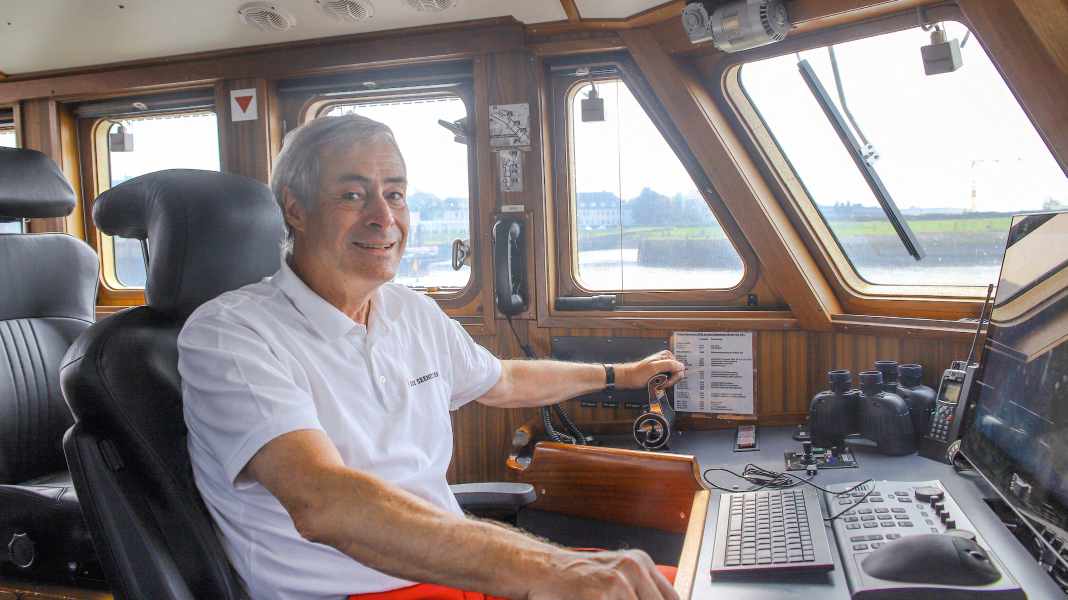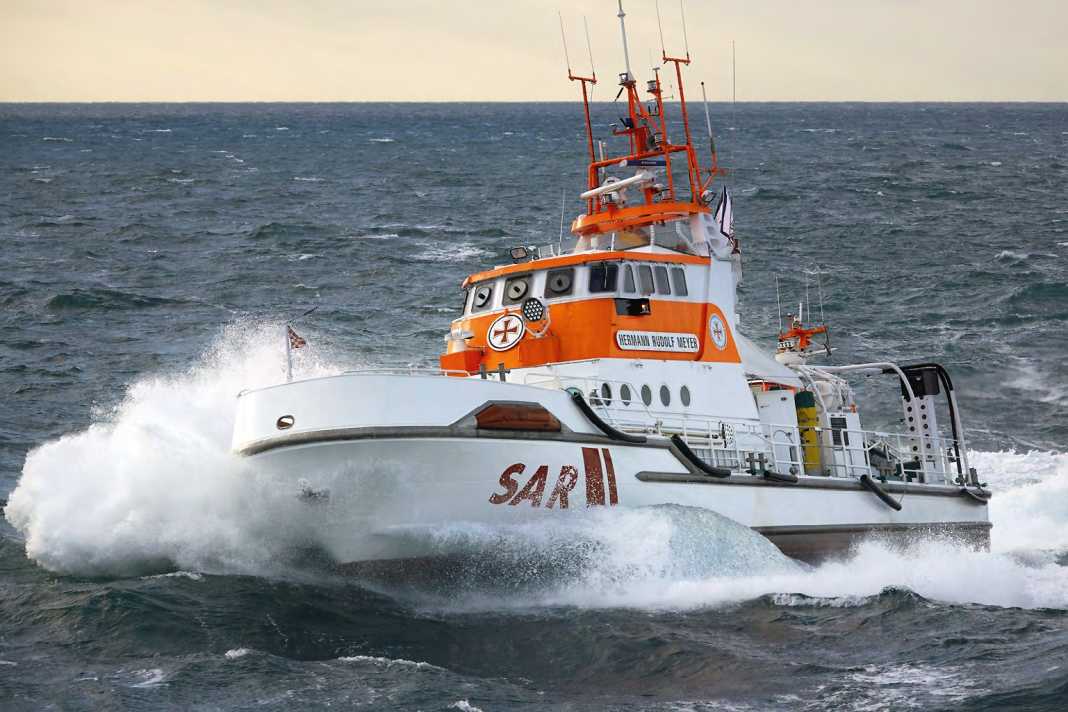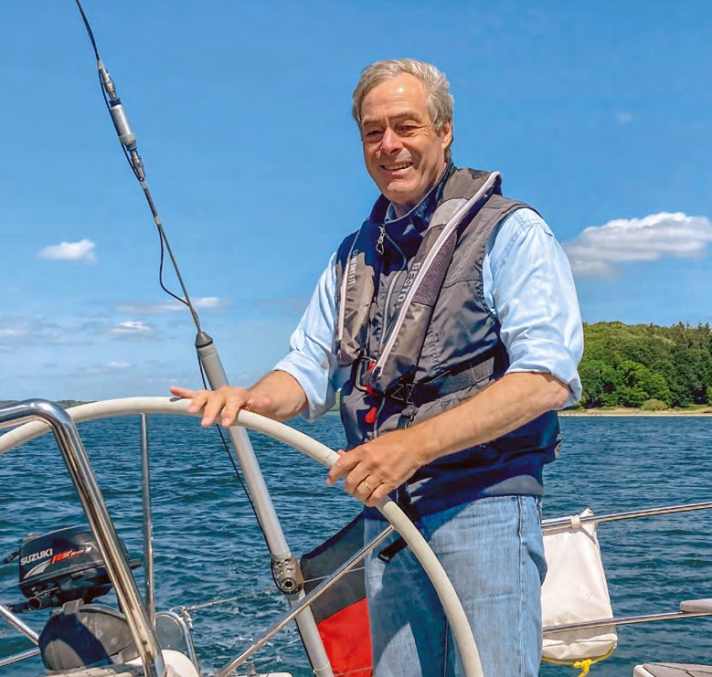
The German Maritime Search and Rescue Service (DGzRS) elected Ingo Kramer as its new chairman in the Baltic Sea resort of Kühlungsborn in June. He was previously one of the two deputies and had been a member of the decision-making body of the sea rescuers since 1996, which is effectively the parliament of the DGzRS.
Kramer replaced Gerhard Hader, who had held the position of Chairman since 2010. During his time, a total of 30 state-of-the-art rescue vessels replaced their respective predecessors. "I am very much looking forward to my new role because I am part of a very professional and committed team both at sea and on land," said Kramer after his election.
The 69-year-old from Bremerhaven became nationally known as the employer president. We met him on board the rescue cruiser "Hermann Rudolf Meyer", on which he also serves as a volunteer rescuer.
YACHT: Mr Kramer, you were an influential employer president for many years. Why are you now chairman of the sea rescuers?
This is one of the best jobs I've ever had in my life! I've been with the sea rescuers for a very long time and have been a deputy on the three-member voluntary board since 2010. As a Bremerhaven resident, you always have to deal with the sea, so the sea rescuers are a kind of familiar everyday occurrence here.
What exactly are your tasks at the DGzRS?
An organisation with around 60 ships, almost 200 permanent employees and around 800 volunteer sea rescuers is like a small shipping company, but with a very specific mission. There is a commercial and a nautical-technical managing director for the operational business. The Executive Board is primarily responsible for fundamental decisions and bears overall responsibility.
Do you also travel on rescue missions yourself?
Yes. I have been a volunteer sea rescuer on the rescue cruiser "Hermann Rudolf Meyer" here in Bremerhaven since 2012, which has a permanent crew of four. There is a foreman, an engineer and two lifeguards. In the event of holidays or illness, trained volunteer rescuers occasionally step in, of which I am one. I also drive the daughter boat "Christian" when I'm on duty.
How should we imagine everyday life on board the cruiser?
I'm usually on board around the clock for a week, except in the morning when I go to get bread rolls. Everyone does everything in the harbour: we are always busy with repairs, routine work, care and maintenance. The cruiser has to be able to set sail within a few minutes at any time. It's also important to know your way around; we have to know our area inside out in all weathers. After all, if you want to help others, you have to be safe yourself first. You have to practise, practise, practise. Because it is usually the person who is the weak point, not the boat.
How often do you take part in rescue missions?
I don't count that exactly. Last summer we had three call-outs here in one day: first a boat with engine damage off Blexen, shortly afterwards a sailor had a problem off Brake on the Lower Weser. And as soon as we got back, a yacht ran aground in the evening on a Prickenweg north of Bremerhaven when the water was running out: the wind was coming up, the skipper was older and also alone on board. I then towed him free from the sand with the daughter boat and quite a bit of effort. By then it was pitch dark.





How high was the risk you took yourself?
Not every one of these rescue missions is life-threatening. But if it doesn't take place, it can suddenly become dangerous. I haven't yet had a life-threatening mission, even for me - fortunately! The important thing is to be on site quickly enough to prevent major damage. At our 55 stations on the North Sea and Baltic Sea, this works quite well in the vast majority of cases.
The number of leisure skippers increased noticeably during the pandemic. Have you also noticed this in your work?
We usually have around 2,000 to 2,200 missions a year, in 2020 there were around 300 fewer, but last year things looked different again. My impression is that the majority of recreational boaters endeavour to prepare themselves properly for the given circumstances, complete training courses and have the right papers. And their boats are usually well equipped. There are so many opportunities for training these days. There have always been individual cases in the past where everything looks different.
"No sea rescuer loves a storm. But we dare to. But every beautiful sunset fascinates us more"
The sea rescuers live solely from donations. For many associations and non-profit organisations, this form of funding has become difficult in times of the war in Ukraine. What is the situation like for you?
Over the years, we have had a very consistent, almost constant volume of donations and cannot complain about the loyalty of our donors - quite the opposite! The sea rescuers enjoy a very high status among them. So far, there has been no slump in donations - and there have always been economic crises in the twelve years that I have been on the Board. Young people are also enthusiastic about the sea rescuers. So I am optimistic.
What fascinates you about going out in a storm?
Nothing! No sea rescuer loves a storm. But we dare to do it. We're not afraid of the sea, we've trained too much for that. But we always have respect. Every beautiful sunset fascinates us more than a storm.
You are a passionate sailor. When did that start?
I grew up in Bremerhaven; my parents were involved in shipbuilding, but not actively involved in seafaring. I then joined the navy as a conscript and this time had a huge impact on me: Trained as a navigator, it was there, quite unplanned, that my passion for seafaring was awakened. During my industrial engineering studies in Karlsruhe, I obtained my pleasure craft licence and then started chartering boats with fellow students. Today I am part of a sailing crew with whom I sailed for the first time in 1975, almost 50 years ago! Since then, we have sailed together for a week every year.
Do you have your own yacht?
Yes, although only for about twelve years: a very seaworthy Nordship 40 with a beautiful wooden superstructure. We are a family of six, and the three boys have been sailing the yacht with their own crews since the beginning. A boat for me alone would otherwise not be worthwhile. It's moored in Flensburg, even though the home port of Bremerhaven is written on the stern.
So the North Sea is not your home territory?
The Danish South Sea, the Swedish archipelago, the German Baltic coast, especially around Rügen: For me as a touring sailor, this is unbeatable and cannot be replaced by anything else. Even if the area here on the North Sea off Bremerhaven is very exciting, varied and nautically challenging. For me, the appeal of an anchorage off Lyø is greater than sailing out the tides. However, my second eldest son has just bought a small Waarschip, which is moored with him in Bremerhaven.
Have you ever had to call the sea rescuers yourself?
No. But the DLRG once helped me in Hohwacht Bay when I kept capsizing near the beach in a borrowed sports catamaran with a hull full of water. But I went overboard once 25 years ago.
"When you're swimming in the sea and see how quickly a boat gets smaller, it's suddenly a completely different perspective"
What had happened?
The weather was very summery, the wind was blowing at 4 Beaufort, the waves weren't too high, so it was fantastic sailing weather. I was leaning against the main boom with one hand, but then suddenly a shackle broke on the mainsheet tackle. As a result, the mainsail blew out, the boat moved jerkily - and I was out in the water. Of course, I was wearing a lifejacket. But when you're swimming in the sea and see how quickly a boat like that shrinks, it's suddenly a completely different perspective. It gives you a strange feeling. That was a lesson for me! Especially as my rescue by my fellow sailors, who had been experienced since their student days, felt much longer than was objectively the case.
In your opinion, has the behaviour of boaters changed in recent years?
I don't see any deterioration and believe that the vast majority of sailors are very aware of the potential risks. As my own case shows, things can get dicey quite unexpectedly. The importance of leisure time is increasing, but this also goes hand in hand with an increase in information. I'm not sure if everyone still masters terrestrial navigation. But thanks to all the often redundant electronic aids on board, awareness of this is no longer so pronounced. For me, taking a bearing is no problem even today. That's why I've done a lot of night sailing with my children - one of the best for me to this day is sailing through Svendborg Sound in the dark.
As Chairman of the DGzRS, what would you like to pass on to water sports enthusiasts?
In addition to all the good training and the good condition of all the equipment you have on board, it is important to keep a good feeling for potentially dicey situations. You should never disregard your gut feeling and sixth sense. You shouldn't allow yourself to be put under time pressure and always keep your wits about you. If in doubt, it's always better to do less, stay in harbour and play it safe, especially as a skipper. I, for example, generally don't leave the harbour when the wind is blowing stronger than six forces.
Personal details: Ingo Kramer, 69
From 1982 to 2018, the industrial engineer was managing partner of the J. H. K. Group, a plant engineering company based in Bremerhaven. Kramer is an FDP member and was President of the Confederation of German Employers' Associations from 2013 to 2020. He has four children and is a passionate sailor.

Five facts about the sea rescuers
How the DGzRS is organised and managed
- The German Maritime Search and Rescue Association (DGzRS) is not a registered association, but an association with legal capacity by virtue of state conferral - a so-called "old law association". The reason for this is that the DGzRS was founded in 1865 and is therefore much older than the German Civil Code, the introduction of which in 1900 led to the creation of the registered association (e.V.). The Senate of the Free Hanseatic City of Bremen granted the DGzRS the rights of a legal entity as early as 1872. Its status is comparable to that of an e. V.: it is recognised as a non-profit organisation and can issue tax-deductible donation receipts.
- The three-member board of the DGzRS works on a voluntary basis. It is currently made up of Chairman Ingo Kramer and Deputy Chairmen Matthias Claussen and Lars Carstensen. The 75 members of the decision-making body are also volunteers. This is the highest legislative body of the DGzRS; it meets every two years. A six-member Advisory Board advises the Board of Directors and ensures that the organisation's funds are audited and monitored. The full-time management at the headquarters in Bremen is carried out by the managing directors Captain Michael Ippich (Rescue Service/Inspection) and Nicolaus Stadeler (Finance).
- In addition to around 180 permanent employees, more than 800 volunteer sea rescuers work on board the 60 rescue units. On land, around 650 people across Germany also volunteer for the DGzRS.
- The rescue fleet consists of around 20 rescue cruisers and 40 rescue boats. They are stationed along the entire German North Sea and Baltic Sea coast. The cruisers have been specially developed for maritime search and rescue services, are extremely seaworthy vessels with a daughter boat and are usually manned around the clock by permanently employed rescuers. They are stationed at important coastal points, from where they primarily secure the major shipping routes. Sea rescue boats are smaller, no less seaworthy vessels without a daughter boat. They are manned a few minutes after the alarm is raised and are driven by volunteer crews.
- The service flag of the DGzRS shows the red Hanseatic cross on a white background with a thin black border. This cross appeared in the flags, coats of arms and seals of some Hanseatic cities centuries before the DGzRS was founded.
- More info at seeotretter.de

